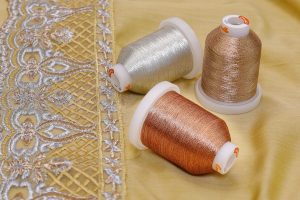Being a new entrepreneur or an enthusiastic embroidery learner, you must have noticed some embroideries that have a subtle sparkle to them and look very appealing. They catch your attention instantly while still being not too shiny. Metallic embroidery threads add decorative stitches to the project and add that extra attractive element to it. However, it is not always easy to use metallic threads, this article will take you step by step in order to avoid trouble in the first place.
The first step is to clean everything, may it be machine, bobbin, or needle. Cleaning the machine is important because this way your machine will be in excellent running condition and there will be no chance of fluff or particles being stuck causing additional thread breakage.
Use new needle and right size needle for the project. Ideal size of needle is 80/12 or 75/11. Using new needle will ensure excellent running condition for metallic threads.
Reduce the thread’s tension than usual. Reduction in thread tension will save you from frequent thread breakage as the metallic threads are very delicate in comparison to polyester or rayon threads. In general, recommended thread tension for top is 80-100 gf or cN and 25 gf or cN for bottom.
Slow down the machine speed as it will be more productive as there will be less embroidery thread breakage interruptions.
Ensure the digitizing is done keeping metallic threads in mind. It is advisable to reduce density and stitch length for metallic threads as putting too many stitches in a small space will cause thread breakage frequently.
If you follow above steps, you can easily use metallic threads with minimum interruption due to delicate nature of the threads.
Additional Tips
Before you start, following additional tips will help you immensely to increase your productivity while avoiding the common blunders.
Metallic threads are not advisable for small lettering as they can have too many stitches in one place which will cause thread breakage.
Use superior quality threads in the first place as poor quality will always slow you down and will not generate the quality results you are hoping for. Dipping in silicone or freezing those low-quality spools will not resolve the problem.
Use basic white thread for light color fabric and grey for dark color in bobbin.
Needles with bigger needle-eye are preferred for metallic thread embroidering as the metallic thread can cause abrasion to the needle eye if the eye is small.
Softer fabrics with softer backings and stabilizers are preferred for metallic threads.
Iron the backing after completing the metallic embroidery to smoothen the metallic threads and improve the hand feel.
Stitch density and length are equally important factors so pay attention to both.
When metallic threads run through the needle eye while embroidering, the needle can become hot due to friction between the needle and the metallic thread, when this happens, allow some time to cool down for optimum results. Alternatively, the best way to use metallic threads would be to use slower speed to avoid heating up in the first place.
Little silicone on the metallic spools can also keep them cooled down.
If you are combining normal thread and metallic thread in the embroidery then use polyester instead of cotton as cotton threads grab metallic ones more often causing thread breakage.
Always experiment on extra fabric first before running the metallic thread on main project fabric.
You can also use metallic threads with bobbin as this will save the thread from going through the needle-eye hence saving the wear and tear of the thread and the needle. This will also result in less thread breakage and good results. You can also use invisible thread for needle and metallic thread for bobbin and turn the fabric upside down for better results. This is especially useful when metallic thread is heavy and running it through needle will cause a lot of wear and tear.
Conclusion
If you are following every step and considering every tip mentioned above and still not satisfied with the results then experiment for a while to understand the optimum settings suitable for you. This happens because every machine is different so take your time in switching the threads needles, stitch density, stitch length and tension. If you find this article helpful and are interested in more information on various topics related to embroidery then head to our main blog.

